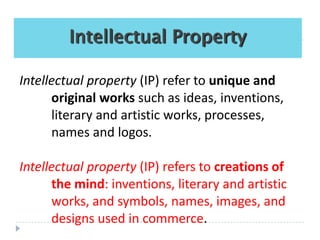3.1.1 computer ethics
- 1. 4.0 COMPUTER ETHICS AND SECURITY 4.1 Computer Ethics 4.1.1Intellectual Property
- 2. LEARNING OUTCOMES :  At the end of this topic, students should be able to:  Define Intellectual Property.  Identify types of Intellectual Property.  Describe the importance of Intellectual Property
- 3. Intellectual Property Intellectual property (IP) refer to unique and original works such as ideas, inventions, literary and artistic works, processes, names and logos. Intellectual property (IP) refers to creations of the mind: inventions, literary and artistic works, and symbols, names, images, and designs used in commerce.
- 4. Types of Intellectual Property IP is divided into two categories: i. Industrial property ii. Copyright
- 5. Types of Intellectual Property Industrial property, which includes inventions (patents), trademarks, industrial designs, and geographic indications of source;
- 6. Types of Intellectual Property Copyright, which includes literary and artistic works such as novels, poems and plays, films, musical works, artistic works such as drawings, paintings, photographs and sculptures, and architectural designs.
- 7. Types of Intellectual Property ÔÇß is an exclusive right granted for an invention, which is a product or a process that provides a new way of doing something, or offers a new technical solution to a problem. invention - a product or a process that provides a new way of doing something, or offers a new technical solution to a problem
- 8. Types of Intellectual Property ÔÇß patents needed to protect inventions, and industrial designs, which are aesthetic creations determining the appearance of industrial products
- 9. Types of Intellectual Property A trademark is a sign which distinguishes the goods and services of one trader from those of another. A mark includes words, logos, pictures, names, letters, numbers or a combination of these.
- 10. Types of Intellectual Property Trademarks is a service marks, layout-designs of integrated circuits, commercial names and designations, as well as geographical indications, and protection against unfair competition.
- 11. Types of Intellectual Property Connecting People
- 12. Types of Intellectual Property A copyright gives authors and artist exclusive rights to duplicate, publish, and sell their materials. A legal term describing rights given to creators for their literary and artistic works.
- 13. Types of Intellectual Property relates to artistic creations, such as books, music, paintings and sculptures, films and technology- based works such as computer programs and electronic databases.
- 14. Types of Intellectual Property A legal term describing rights given to creators for their literary and artistic works.
- 15. Types of Intellectual Property Literary works - novels, poems, plays, reference works, newspapers, computer programs, databases, films, musical compositions, and choreography  Artistic works - paintings, drawings, photographs, sculpture, architecture, advertisements, maps and technical drawings
- 16. Importance of Intellectual Property A patent or utility innovation protection gives the owner of the patent/utility innovation the exclusive right to stop others from manufacturing, using and/or selling the owner's invention in Malaysia without the owner's consent or permission.
- 17. Importance of Intellectual Property A trademark helps to identify the source and those responsible for the products and services sold in the market. A trademark enables consumers to choose goods and services with ease while shopping. Consumers choose a particular trademark for its known quality.
- 18. Importance of Intellectual Property Generally, owners of copyright works in literary, musical or artistic works, films and sound recordings have the exclusive rights to control: •the reproduction of the works in any form (including photocopying, recording etc); •the performing, showing or playing to the public; •the communication to the public; •the distribution of copies to the public by sale or other transfer of ownership; and •the commercial rental to the public.
- 19. Importance of Intellectual Property  To protect any original work that created by individual person/ company for example, image, drawing, lyric, publishing and so on.  Preserve the features and processes that make things work. This lets inventors profit from their inventions.


















